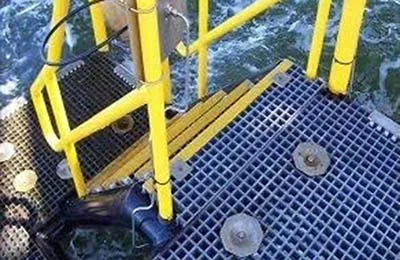Introduction
Offshore environments are among the most challenging settings for construction materials, demanding high resilience against corrosive elements, extreme weather, and heavy loads. Enter GRP grating (Glass Reinforced Plastic grating)—a modern solution designed to meet the rigorous demands of the marine and offshore industries. This article explores the top 5 advantages of GRP grating, making it an ideal choice for offshore applications.

offshore grp grating
What is GRP Grating?
GRP grating is a composite material made from a combination of fiberglass and resin, resulting in a lightweight yet highly durable product. Unlike traditional materials such as steel or aluminum, GRP grating offers superior resistance to corrosion, making it a go-to solution for harsh environments like oil rigs, marine platforms, and coastal facilities.
Its defining features include:
- Corrosion resistance
- Non-conductive properties
- Lightweight design
These attributes have made GRP grating indispensable in industries requiring safety, longevity, and reliability.
Advantage 1: Corrosion Resistance
Offshore structures are constantly exposed to saltwater, chemicals, and moisture, which can cause rapid corrosion in traditional materials like steel. GRP grating is inherently resistant to these elements, ensuring a longer lifespan and reduced maintenance requirements.
For example:
- GRP grating does not rust or deteriorate even when submerged in seawater.
- It withstands exposure to harsh chemicals often present in offshore facilities.
This durability translates to reduced replacement costs and fewer operational disruptions.
Advantage 2: Lightweight and Easy to Install
One of the standout features of GRP grating is its lightweight nature, which makes transportation and installation significantly easier than traditional materials.
- A GRP panel weighs only a fraction of what a comparable steel panel would, reducing the need for heavy machinery during installation.
- Its modular design allows for quicker and more flexible installation in confined or hard-to-reach offshore spaces.
This advantage is particularly beneficial for temporary structures or projects requiring frequent reconfiguration.
Advantage 3: High Strength and Durability
Despite being lightweight, GRP grating offers exceptional strength-to-weight ratios. It can support heavy loads without deforming or cracking, making it suitable for walkways, platforms, and equipment-support areas on offshore rigs.
Key durability benefits include:
- Resistance to impact and structural stress.
- Ability to withstand fluctuating temperatures and UV exposure.
These qualities ensure that GRP grating maintains its integrity even in extreme environmental conditions.
Advantage 4: Enhanced Safety Features
Safety is a top priority in offshore environments, and GRP grating delivers with:
- Non-slip surfaces that prevent accidents caused by wet or oily conditions.
- Fire-resistant properties that reduce risks in high-temperature settings.
Additionally, GRP is non-conductive, minimizing the risk of electrical shocks—a crucial safety feature for facilities with electrical equipment.
Advantage 5: Cost-Effectiveness Over Time
While GRP grating may have a higher upfront cost compared to some materials, its long-term cost benefits make it a worthwhile investment.
- Minimal maintenance: GRP requires little upkeep, unlike steel, which needs regular painting and anti-corrosion treatments.
- Extended lifespan: The durability of GRP reduces the frequency of replacements, lowering overall costs.
For companies operating in offshore environments, these savings can significantly impact the bottom line over time.
Applications of GRP Grating in Offshore Environments
GRP grating is widely used in:
- Oil and gas platforms: Walkways, staircases, and equipment flooring.
- Marine decks: Areas exposed to constant saltwater spray.
- Coastal infrastructure: Jetties, docks, and bridges.
Real-world example: On a North Sea oil rig, GRP grating replaced traditional steel grating, leading to a 30% reduction in maintenance costs over five years.
Conclusion
GRP grating has transformed offshore operations with its corrosion resistance, lightweight design, high strength, enhanced safety, and cost-effectiveness. These advantages make it an essential choice for industries seeking reliable and durable solutions in harsh environments.
If you’re planning an offshore project or looking to upgrade your current materials, consider GRP grating for a solution that balances performance, safety, and long-term value. Contact us today to learn more or request a customized quote!




























